WHY I SWITCHED TO THE WAHOO ELEMNT BOLT

In the battle of Wahoo vs. Garmin, the Wahoo ELEMNT BOLT outperforms the Garmin Edge 530 from my comparative review of what’s most important in choosing a road bike computer. It’s also simpler to both set up and use and it costs slightly less. You can get it here, here, and here for US and Canadian residents and here for those in the rest of the world from stores I recommend because of their competitive pricing and customer satisfaction ratings.
I bought the Wahoo ELEMNT BOLT when it first came out in 2017 to add to my collection of bike computers that help me test power meters side by side. Little did I know then that the Wahoo BOLT would become the one I would choose, replacing my Garmin Edge 520 when I ride with just one bike computer.
Even after the Garmin 530 was introduced, I compared it and found the original Wahoo BOLT still worked better as a road bike computer, was easier to use, and was less expensive. Unless you preferred color maps, were already tied into the Garmin ecosystem, or really wanted one of Garmin’s unique features, I couldn’t see a good argument to put up with the many everyday disadvantages of the Garmin 530 bike computer.
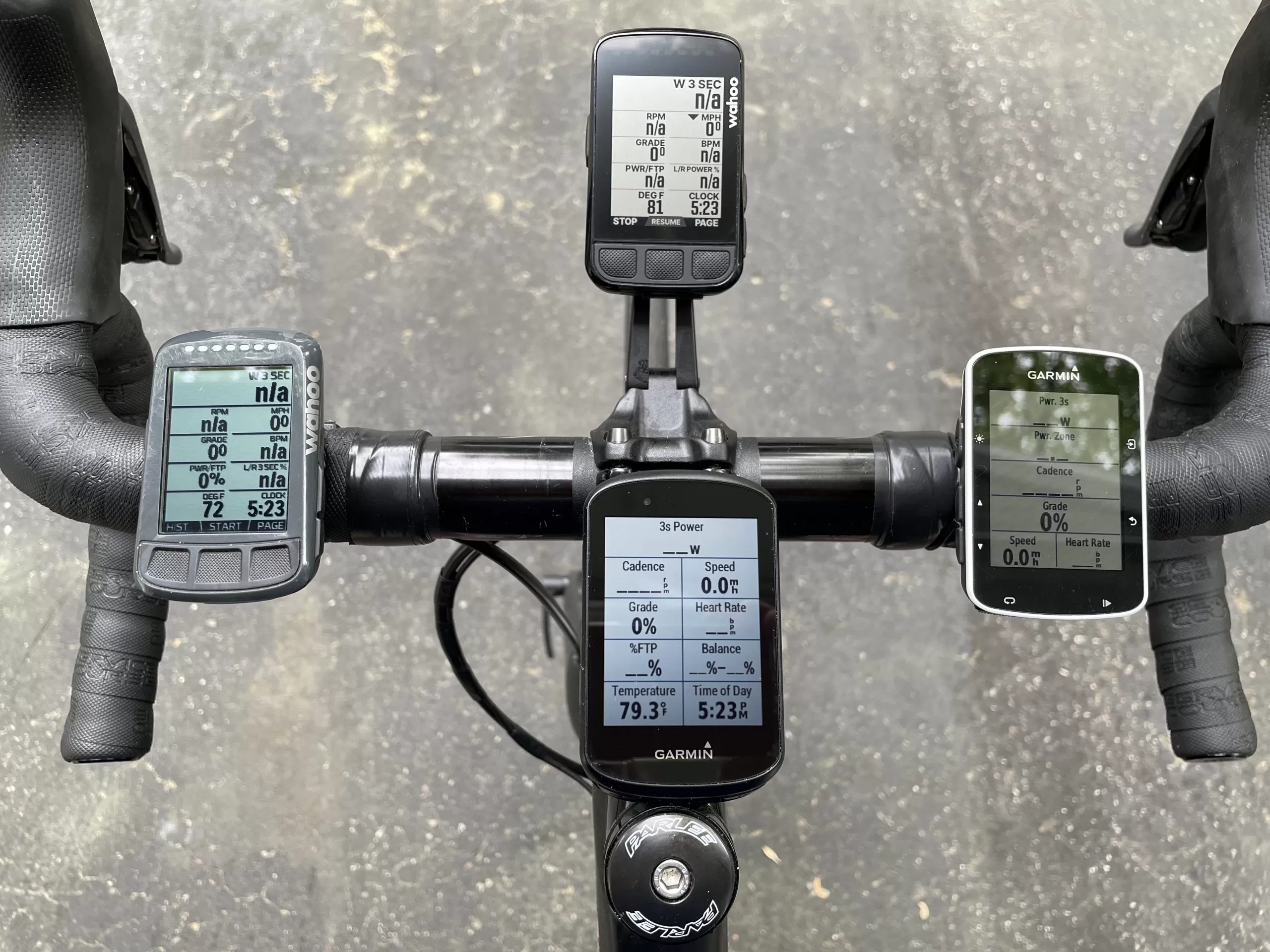
12:00 – Current Wahoo ELEMNT BOLT; 3:00 – Garmin Edge 520; 6:00 – Garmin Edge 530; 9:00 original Wahoo ELEMNT BOLT
Now that the second-generation Wahoo ELEMNT BOLT has come out, this Wahoo vs. Garmin battle weighs even more in Wahoo’s favor. This Wahoo BOLT V2 adds both attractive and useful color and is the equal of Garmin in navigation. The BOLT continues to have a better screen and displays, works more intuitively, is easier to set up, has a simpler interface, a longer battery life, and a lower price than the 530.
If you are buying a bike computer for your road or gravel bike for the first time, the BOLT is the better choice for these and other reasons I’ll detail below. Even if you are a Garmin owner that’s been thinking about upgrading or replacing your bike computer, the latest BOLT is so good that you might want to consider switching over to it if you don’t live by Garmin metrics.
Beyond that, the only reasons I could see for buying a Garmin 530 would be that you are principally a mountain biker or you’re the cycling equivalent of a one-issue-voter, ie., you want a certain feature that only the Garmin has so much that you will put up with all of its disadvantages.
There are other bike computers sold by Wahoo including the Elemnt ROAM, by Garmin like the Edge 830 and Edge 1040, and by others like the Hammerhead Karoo 2 that come with larger displays, touch screens, and offer additional features beyond those on either the Wahoo BOLT or Garmin 530. While it’s smaller than the demand for BOLT and Edge 530 units, there’s a market for all of these devices and reasons to want some of them. But, I don’t see a reason for the regular road and gravel cycling enthusiasts to need more than that what the BOLT does or spend more to get it unless your vision requires a bigger screen, you spend most of your time on your navigation screen, or you want and are willing to pay for all the bells and whistles.
In The Know Cycling is ad-free, subscription-free, and reader-supported. If you want to help keep it rolling without any added cost to you, buy your gear and kit after clicking the store links on the site. When you do, we may earn an affiliate commission that will help me cover the expenses to create and publish our independent, comprehensive and comparative reviews. Thank you, Steve. Learn more.
Among the things I believe matter most in choosing a head unit, here are the ways the Wahoo ELEMNT BOLT and Garmin Edge 530 compare and how the BOLT almost always comes out on top.
SCREEN AND DISPLAY
While the Edge 530 has a slightly larger screen, the Wahoo ELEMNT BOLT’s screen is sharper and brighter than the 530. For a middle-aged, far-sighted fart like me who wears glasses or contacts to read and see computers including those that guide me and my bike for hours each week, I find the BOLT’s screen far easier to read and a difference-maker between the two units.
The Wahoo ELEMNT BOLT’s sharper and brighter screen is notable when the size of the data or maps are the same. But even better, the BOLT gives you ways to display your data that make visualizing what’s on your screen even easier.
As shown in the photo series below, you can change the font size on the data on your BOLT merely by toggling the up/down buttons on the right to decrease or increase the number of fields you have on the screen at any time. While we’re all different, I find displaying more than 4 data fields for more than a few seconds may mean that you aren’t focused and perhaps distracted by things that don’t matter. Too much cognitive load!
To help keep you focused, note that the first number on a data page with 3 to 7 fields is always larger than the others. If you like to focus on one number to guide you as you ride – perhaps your speed or cadence or, in my case, my average 3-second power – this larger top number stands out that much more while the other numbers that matter to you are clear but smaller and below it.
You can change the font size and number of fields on the 530 but you have to set up a different page to do that. With the Wahoo ELEMNT BOLT, you change the number and size of the fields within the page you already have set up with the zoom in/out buttons on the right side of the device.
In both units, you have a limited number of pages. However, with the BOLT, you don’t need to add pages or change between them nearly as often as you do in the 530 to get the same info.
You can also zoom in or out on the BOLT’s map page with the same right-side buttons you use to change the number of fields and font size on the data pages.
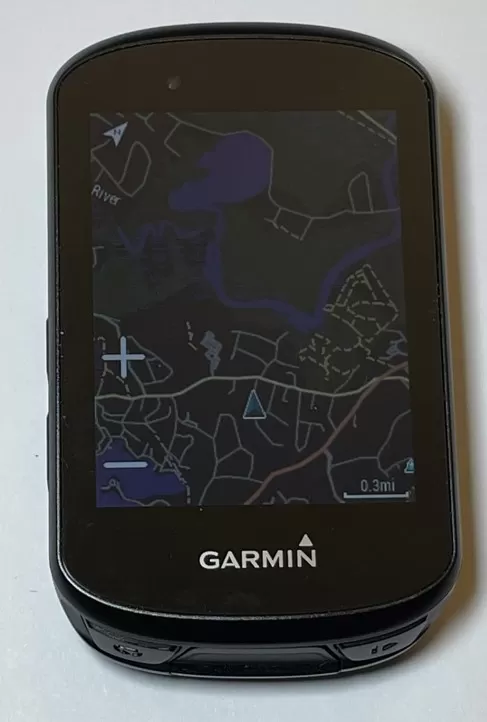 With the 530, you can choose auto-zoom or set a zoom level on a settings page but once underway, you need to go away from the map page, push a half-dozen buttons to change the zoom level, and then come back to the zoomed map screen. Auto-zoom brings you a one-block radius which I don’t find terribly useful. If you want to change the amount of zoom again, you have to go away from the map and start the half-dozen button-pushing steps once again.
With the 530, you can choose auto-zoom or set a zoom level on a settings page but once underway, you need to go away from the map page, push a half-dozen buttons to change the zoom level, and then come back to the zoomed map screen. Auto-zoom brings you a one-block radius which I don’t find terribly useful. If you want to change the amount of zoom again, you have to go away from the map and start the half-dozen button-pushing steps once again.
It’s just an example of how the device-level user interface, let alone the smartphone one, makes the BOLT so much easier to use.
While color on maps is a nice-to-have feature, the latest generation BOLT adds color to your power and heart rate fields. This allows you to see what zone you’re in and how hard you are working (or not) in a dumbed-down way rather than translating your watt and heart rate readings to your zones.
Finally, I find the Wahoo ELEMNT BOLT screen sharp and bright enough that I don’t need to use any backlight riding outside during the day and with the room lights turned on while on a trainer. I used to run my 530 at 80% brightness with a 15-second timeout and often found myself toggling between pages just to turn the backlight on. BOLT’s advantage here obviously saves battery if you do a lot of toggling or you just want to see your screen. It also saves you the need to toggle as often and keeps both hands on the bars when riding outside.
Call me old-fashioned but I’ve never seen much value in the use of color. Yes, it is nice to see the color contrast between different types of roads that Garmin introduced and Wahoo now also provides on the BOLT (and Roam). The second-generation BOLT now adds some functional gains by color-coding your zones.
Bottom line is that the BOLT’s sharper, brighter screen without the need to draw down the battery with backlighting, the way it uses the real estate within a page, and the ease of zooming data pages and maps make the Wahoo ELEMNT BOLT’s advantage here is clear (pun intended)!
SETUP
The Wahoo ELEMNT BOLT takes advantage of the touchscreen on your smartphone to make setting up your pages easy. Using the ELEMNT companion app on your smartphone, you drag and drop the data fields you want to the pages you want. You can put the fields in the order you want by simply dragging them into position.
The first time I did hill repeats with the Wahoo ELEMNT BOLT, I stopped at the top of the first repeat, pulled out my phone, and added and reordered the fields on my lap page based on what I now knew I wanted to see. Took me about a minute. The changes show up immediately on your BOLT screen. (I wish it had taken longer. I needed an excuse to catch my breath.)
You can find, pair your power meter, cadence, heart rate, trainer, etc. sensors and pick your route from the smartphone app as well. You can also do this on the BOLT itself but I find it’s much easier on the phone.
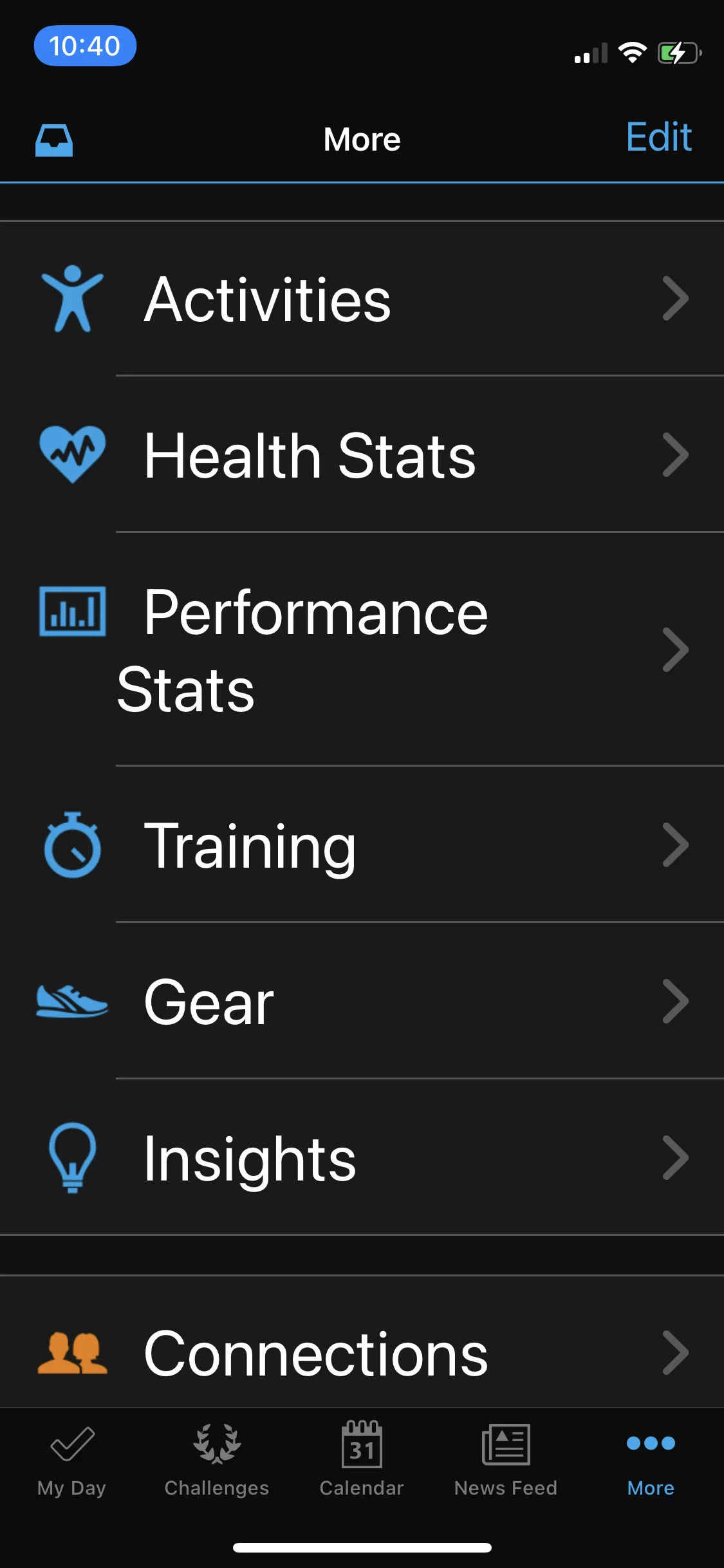
The Garmin Connect app tries to be a cross between Strava and Training Peaks but doesn’t help you set up or use your Edge 530
The Garmin Connect smartphone app doesn’t help you do any of this – set up fields on pages, pair sensors, or pick routes on your Edge 530. You do all of those things on the device. Instead, the app tries (and in my view fails) to be a cross between Strava and Training Peaks but
Setting things up the 530 unit itself isn’t hard, but it’s a rather tedious series of button pushes back and forth and it’s not intuitive.
In the touch screen phone world we live in, Wahoo ELEMNT BOLT is hip and the 530 is old school or the BOLT is dope and the 530 is whack or whatever words hipper enthusiasts than me actually use.
Note that you don’t need to ride with it to make the BOLT work.
I haven’t done a side-by-side comparison but both the BOLT and 530 have tons of fields to choose from. There weren’t any fields I wanted that I couldn’t find on either
In Garmin’s favor, the 530 triggers a reminder on your screen to zero-offset your power meter when you wake that sensor up.
With the Wahoo ELEMNT BOLT, you don’t get a reminder. You have to open the menu (push the on-off button once), highlight the power meter in your sensor list (scroll to it with the down button) and push the calibrate button (left button on the front of your screen.)
Even though some of the newer power meters claim their technology doesn’t make it necessary, power meters are still finicky enough that I recommend you zero-offset yours once your bike is at the outside temperature at the beginning of each ride. It takes 15 seconds and will help ensure training data consistency from ride to ride.
OPERATION
The buttons on the Wahoo ELEMNT BOLT make a lot more sense and I find are far more intuitive than on the 530.
The on/off button on both bike computers is on the upper left. That makes sense as that location is the least natural spot to put a button for the right-hand-dominated world on a ride (sorry lefties). You’ll use it before you set off on your ride and then won’t have a need to reach for it again unless you want to change settings mid-ride, which I don’t suggest you do while rolling.
The Edge 530 takes about 15 seconds to go from being totally powered off to your first data page. It also has a sleep mode that it re-awakens from instantaneously. The Wahoo BOLT takes a stupidly long 45 seconds to start up and has no sleep mode. If inactive or you forget to turn either bike computer off, both will shut down automatically after a period of time you can set.
Switching between pages, something you’ll do frequently during a ride is a very different experience on the two units. With the BOLT, you merely press the right button on the face with a finger of the device to go to the next page. If you want to go 2 pages ahead, press the button twice. Simple. The button is slightly raised and is easy to depress.
To change the page on a 530, you press either a raised forward or back button that sit together on the lower left edge of the device. If you are a righty, you have to reach over the 530 and use your thumb to toggle these buttons.
Because my thumb is fatter, shorter, and less agile than my fingers and because the two buttons on the 530 are so close together, I find it easier to use a finger from my left hand to toggle these. Of course, if you’re a lefty, using a finger from your dominant hand is an obvious first choice.
But, either way, using your left hand to make these page changes moves it away from the area of your left brake lever. That’s the one that controls your front brake on bikes in most of the world and the one you should use first when slowing your road bike.
Further, you are taking your hand away from the area of that lever AND probably looking at your head unit to see the results of the page change you’ve made. This is truly a bad combination when you should be looking at the road and all that is going on with the riders around, you ready to brake when necessary.
On the right edge of these bike computers, you also have different layouts. Similar to the left edge lower buttons on the 530, the right edge lower ones on the BOLT are essentially opposing buttons though larger and spaced further apart. While the 530 buttons on the left edge switch between pages, the BOLT’s right edge buttons zoom in and out data font size by reducing or increasing the number of fields on a page and zoom the map in or out.
The 530’s right edge buttons move you back and forth between menu options and confirm the option you want. Helpful, useful but seemingly a waste of a key edge for right-handed cyclists unless you are doing a lot of menu changes mid-ride, something I’d expect most don’t.
And then there are the buttons you’ll use the most during a ride. These are the ones that start/pause/resume/end a ride, start a new lap, change the page you are on (BOLT only), and confirm certain actions (BOLT only).
There are three of them only the Wahoo ELEMNT BOLT, each slightly raised above the face of the bike computer and easily clicked with a forefinger. They also have labels just above them that tell you what they do for the screen you are on.
I find this far superior to the two 530 buttons on either side of the edge at the bottom of the Garmin bike computer. These perform the critical start/pause/resume and lap actions and leave others like changing pages or menus to the right and left edges as I described earlier.
For me, I can never quite figure out whether it’s best to use my thumb or a finger to push these Garmin buttons. With some out-front mounts or if you put the unit on your stem rather than in an out-front, there’s often not a lot of room for your thumb to get to them and a longer finger may require you to flip your hand palm side up to get a good angle.
Ergonomically and logically, operating the BOLT is a superior experience. It’s almost as if Wahoo studied what worked and didn’t about the Garmin units before designing their own to improve on the things that were harder to do or made less sense.
Unfortunately for Garmin, after years of making and getting users accustomed to several generations of Edge family menus, logic, and button locations, it would be quite disruptive to make the kind of fundamental changes that Wahoo and more recently, Hammerhead has made to the basic operation of bike computers.
NAVIGATION
Comparing the navigation abilities of the Wahoo ELEMNT BOLT and Garmin Edge 530, I considered several key performance categories which I’ll discuss separately below.
Maps and Uploading
I ride a lot of regular routes I know where I don’t need or use the GPS navigation feature. When I head out on a new group ride or do an event, however, I do use navigation because it’s often a route I haven’t ridden before or for a while. I like the confidence of knowing where I need to make the next turn especially if (when?) I fall off the back or it’s time to take my turn pulling. My sense of direction has also atrophied since I began using a car GPS years ago and was never very good in the first place.
The Garmin Edge 530 has a robust set of road maps that the 520 didn’t. The 520 Plus did have a much better map set but used the same processor as the 520 and navigated way too slowly. You could miss a turn or get notified after the turn waiting for the Plus to navigate your map.
Garmin fixed that with the faster processor that came with the 530 that keeps it navigating without delay. Further, the 530 also added trail and mountain bike maps to support your diversions from road cycling. This was a welcome addition for those of us roadies venturing into gravel riding.
Wahoo’s latest ELEMNT BOLT meets the Edge 530’s map range and speed challenge. It comes pre-loaded with detailed road and off-road maps from around the world and has plenty of room to upload the routes I’ve saved in cloud apps.
While I do ride gravel, comparing the range of MTB maps available on the BOLT and 530 is outside my scope. (This is a review site for road cycling enthusiasts after all.) Garmin has the Trailforks map set pre-loaded on the bike computer. Trailforks claims something like 370,000 mountain bike trails and ratings in 123 countries.
For their part, the BOLT claims to be able to navigate any route that is on a map. Which map sets, I don’t know. They do upload OpenStreeMaps, the user-generated map source on the BOLT and you can update that free source regularly or whenever you go to a new area.
As with the Wahoo ROAM, the BOLT also can download Trailforks, MTB Project, and Singletracks routes in the same way it does those from Strava or RideWithGPS. Most of those services are free or come with a monthly fee if you want the premium plan.
Not that I’ve found I needed it with the 4x storage increase from the original to the current BOLT (now equivalent to the 530’s storage at around 16GB), you can also remove stored or pre-loaded maps (and add them back later) from regions of the world and nearby countries or states where you don’t normally ride.
With the 530, Garmin caught up with some of the innovative, important, and truly differentiating functionality of the original BOLT.
Most notably, with the 530 you can upload routes from Ride With GPS, Strava, and other route mapping apps over WiFi. With the 520, you had to plug the device into your Mac or Windows computer with a Garmin-specific USB to micro-USB cord and upload your route file to the right folders.
Except for what maps might chart the roads and trails near where you live, I find the maps and uploading process quite good on both the BOLT and 530 now.
Finding and Starting a Route
To find and then start a route on the 530, you need to push buttons on either edge of the unit through four menus (Menu>Select Activity Profile/Road>Navigation>Find a Course Option) including some up-down scrolling to get to your course.
With the Wahoo ELEMNT BOLT, you hit the page button at the bottom of the screen until the map page comes up (usually one push from the workout page the BOLT initially powers to). Then you push the route button also at the bottom of the screen on that page and scroll down and enter your route. Intuitive. Done. Worry about other things.
The 530 puts your routes in alphanumeric and alphabetical order. BOLT gives you the option to sort your routes the same way as the 530 but also by route length, proximity to your current location, and date that you added it.
I find the date listing really handy. If, for example, you are doing Wicked Right for the first time (shame) and just loaded it from Ride with GPS, the route will be at the top of your BOLT list. On the 530, if you’ve got 50 or more routes saved to your device as I do, you might need to scroll through a long list of routes to get to the one you want to ride.
Once I’ve picked a route, the ride comes up equally fast on both the BOLT and 530. Some may say one is faster or slower than the other. I guess that it’s more a function of the signal and route density in the area where you’re using your bike computer rather than the speed of its processor.
Because it takes less effort to get to the route selection page and actually picking the route is easier on the BOLT, I give it the advantage for this category.
Navigation Display
While both the BOLT and 530 have color screens that I find sufficiently good for navigation. BOLT shows main roads in darker colors and widths than less traveled roads. The 530 puts the road names on their maps. I don’t see these more as preferences than differences which make one or the other bike computer better or easier.
If you have chosen a route to ride, they go about the task of displaying that route in slightly different ways.
Garmin uses bright pink color to show the route you’ve selected, a white arrow pointing from and to your next turn along with the distance to that turn and the name of the street you are turning on.
Wahoo uses a series of bold black chevrons for your route, wraps those chevrons for each turn, and also shows the distance to the turn and name of the street you should turn on.
I find the cascade of chevrons more distinctive than the shocking pink though I do fine with each.
What I do find different and helpful is that you can put any two data fields at the top of your navigation screen on the BOLT. This allows me to keep on top of the data I use to guide my training – power and cadence – while still having the route up.
As I showed in the array of BOLT map photos in the Screen and Display section above, you can use the up/down buttons on the Wahoo ELEMNT BOLT to zoom in and zoom out the map to get a higher level or more granular view of where you are in relationship to the roads around you and your upcoming turn. I find this feature in combination with the cascading arrows especially helpful when trying to decide which turn to take at more complicated intersections where you might have two or three roads leading in and out of it.
If you have a data page up on the 530 with your regular array of performance fields and come to a turn, the turn notification street name and arrow will overlay the data fields on the bottom third or so of the screen. So, for example, if you have gradient and speed as the bottom two fields of the six on your screen, you won’t be able to see that for the quarter-mile or so from when the notification turns on until it goes off after exiting the turn.
The BOLT merely adds the turn notification to the bottom as if it was two additional fields while shifting the other performance fields up the screen and keeping them fully visible. This is like going from 5 to 7 fields. The 5 fields you were looking at before shift up and get a bit smaller and the turn information shows up at the bottom. Once you exit the turn, the performance fields shift down again.
Likewise, when you get a phone or text notification, the field shifting versus field covering works the same way on the BOLT versus the 530.
Seems like a small thing but I always hated the way the 520 (and now the 530) covered up a couple of my fields and immediately noticed and smiled with satisfaction when I realized they were still there on the BOLT.
With both bike computers now having a color screen, the small things that the BOLT does – the chevrons, being able to have two data fields at the top of the nav screen, and not covering any of the fields when you have a data page up and a turn notification comes in – puts the navigation display comparison in the BOLT win column in my view.
Routing
Both the 530 and BOLT provide turn-by-turn notifications that perform equivalently. Some will say one is quicker than the other in notifying, etc. Riding with the two of them, I’ve found occasionally one will notify sooner than another but it’s never consistently one versus the other. The difference in time between notifications is a few seconds at most and usually always with enough time to execute the turn in an unhurried way.
The latest BOLT can now reroute you to get you back on course. This is something the 520 and 530 always did. and route you back on course the way the 530 does.
Depending on how you have it set up, you can also get audio beeps or red flashing LEDs to alert you when you go off course with the BOLT. Assuming you’re not on your navigation page already, this would prompt you to switch to it to see the map of turns to take to get you back on course.
You can also have the row of LEDs on the top of the BOLT signal you right or left as you close in on your turn. Note that the LEDs are less effective on a sunny day.
Both units can re-route you back to the start by retracing your ride on the route you took.
If you are out riding with your phone (and who doesn’t these days), you can also plug an address into the ELEMNT companion app and have a route automatically created and synced to your BOLT. Wahoo calls this “take me to…” Unfortunately, you can’t use your smartphone to enter an address on the Garmin Connect app to get you to your 530.
You can also create a map on either the BOLT or 530 devices by entering the address or toggling to find a place on the map though it’s a bit more cumbersome that way.
Wahoo also added a couple of new routing features to the BOLT previously available on its more expensive ROAM bike computer. With either the “take me to…” or “route to start” routing options, the BOLT can create the most efficient route on the surface you want to ride. You can choose Road, MTB, Cross, or Hybrid (hello gravel!).
Now that BOLT has caught up to Garmin on rerouting and with their ability to do a few more things and do them on your smartphone, I’d give the edge here again to the BOLT.
Find what you're looking for at In The Know Cycling's Know's Shop
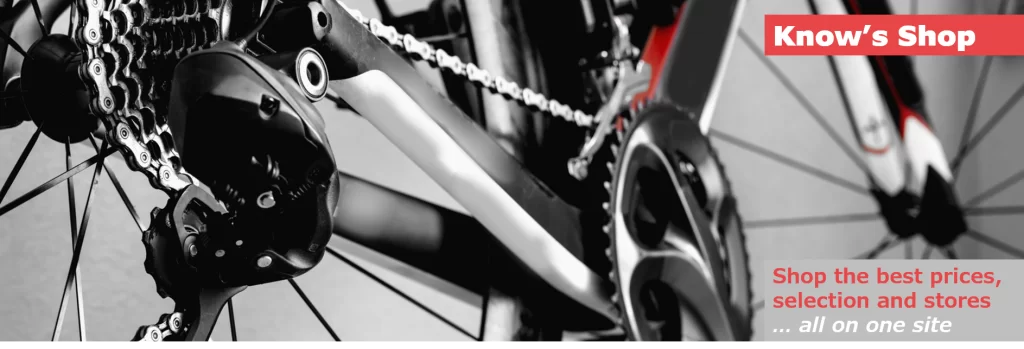
- Compare prices on in-stock cycling gear at 15 of my top-ranked stores
- Choose from over 75,000 bikes, wheels, components, clothing, electronics, and other kit
- Save money and time while supporting the site when you buy at a store after clicking on a link
COMMUNICATION
The BOLT does a superior job of communicating with and controlling your trainer. (Makes sense. Wahoo also makes trainers.) It avoids the need to use 3rd party software to run between the head unit and trainer to control the resistance. If that is important to you, there’s another check for the BOLT.
Both the BOLT and 530 will upload your results to Strava, TrainingPeaks, Today’s Plan, and your other apps that capture and analyze your results. While the 520 required that you plug in the device to your computer using a Garmin-specific micro USB to USB cord, the 530 will now do this over WIFI. The BOLT has always had this capability.
I don’t know about you, but I want to know my results as soon as I push the ride-over button and before I pull out my phone in a WiFi zone and get to those apps.
Here, the Wahoo ELEMNT BOLT excels. The completeness, organization, and presentation of the data are so much better on the BOLT than the 530. It’s also better than the results displays you can get on your Strava and TrainingPeaks phone apps.
Here are a couple of comparisons of the presentation of results (from different rides and with the original BOLT) including a couple to the far right with Zone details that are only available with the BOLT
BATTERY
While both claim a battery life longer than I know I’ll never ride in one day (Garmin Edge 530 – 20 hours, Wahoo ELEMNT BOLT – 15 hours), those numbers are way misleading.
On a long ride, navigation required use mode, I’ve found (as have many I’ve been on those long rides with) that the Wahoo ELEMNT BOLT battery lasts longer than the Garmin Edge 530.
What’s “long ride, navigation required” use? For me, it’s GPS navigation and three ANT+ sensors or devices connected (power meter, heart rate monitor, iPhone). With the 530, I also have the screen backlit at 80% to give me as close to the same screen visibility as the BOLT provides with no backlight. I also set the 530 display to a 15-second timeout and to avoid draining its battery prematurely.
If you want to get text or phone notifications or some of the other features like Live Strava Segments on your 530, you also need to have Garmin Connect turned on which further drains the battery of the Edge (and your phone). The notification is merely a setting in your BOLT that connects to your phone so you don’t need an extra app open on your phone and communicating to your Wahoo.
Using these bike computers side by side in the use case I’ve described above, the BOLT lasts about 10 hours and the 530 about 6.5 hours. Other reviewers have noted as much as a 2X to 3X longer battery life for the BOLT over the 530. Some report more or less the same life.
I’ve not seen anyone report the 530 lasts longer than the BOLT. Depending on how you use it, for example, with some combination of the GPS or Garmin Connect turned off and backlight set to a lower level, I could envision them lasting about the same.
Garmin touts the 530’s “battery saver mode” which they claim doubles the battery life but turns off the screen. Seems like having the display turned off is a rather extreme mode. They also sell an auxiliary battery that snaps into the bottom of a Garmin out-front mount if you really want to extend the 530’s life. It sells for another $130. Uh, no thank you.
In most of my riding, battery life isn’t an issue. Half of my rides are on routes I know so I don’t need to turn the navigation. I also have developed a habit of plugging in my lights and head unit every Sunday (and my Di2 the first Sunday of every month). They usually have enough charge to last through a regular week of 6-10 hours of riding with the limited amount of navigation I use.
I do a half-dozen 100-mile, 6-hour, or longer rides each year where I use the GPS to help me navigate the course as it is usually one I don’t know. \When I used to run the Edge 520, I learned to turn the display brightness down. To conserve battery, I’ll also shut off the navigation when I didn’t need it or traded turns with other Garmin users so we all weren’t navigating and draining our batteries at the same time.
On those “long ride, navigation required” use situations, the 530 battery starts running low in the last third of the ride and gets me wondering whether it’s going to die before my legs and lungs do as we ride together toward the finish.
I don’t need that added mental stress. With the BOLT, I can focus on the ride.
And speaking of stress reduction, the latest BOLT also uses a USB-C connector to recharge the device. These make a more secure connection and charge faster than the micro USB used by the original BOLT and the 530.
FEATURES
On this topic, I’ll admit defeat before even starting the battle.
Not the defeat of one of these bike computers vs. the other, but defeat with some of you dear readers who really love one feature so much that it drives you to buy a bike computer that unique offers it (likely Garmin) wiping out serious consideration of any of the other pros and cons of the unit that might be equally or more important to your riding performance and experience.
You will tell me so in the comments section below, as have so many readers that have gone before you. Uncle!
But, In the ways I and I would dare say most enthusiasts use bike computers, the BOLT and 530 have almost all of the features you need, most that you want but don’t need, and some you neither need nor want. And I’ve tried to describe and compare the BOLT and 530 on this above.
That said, the 530 clearly has more features including some that you never thought about but now may want or feel you need.
Rather than do a comprehensive feature comparison here, I’ll quickly tick off some that go beyond what I’ve written about in the sections above. Since we’re now on the second-generation Wahoo ELEMNT BOLT and moved through the Garmin Edge 520, 520 Plus, and now the 530, it’s easy not to have been able to keep up with all the features you now have available to you. So I’ll try to help you (and me) catch up.
Then, of course, it’s up to you to judge whether each feature is a need-to-have, nice-to-have, or won’t-use-it-even-if-I-have-it and how that affects your decision.
Features that both the Wahoo ELEMNT BOLT and Garmin Edge 530 can do:
- Structured workouts
- Varia radar
- Strava Live segments
- Live tracking – share your location with other riders and interested family and friends. (When’s he coming home to look after the kids?)
Features that only the Garmin Edge 530 can do:
- ClimbPro – BOLT shows you an elevation profile of the route ahead but it’s nowhere near as comprehensive as the distance, grade, and other metrics the 530 displays for a climb
- Accident notification
- Hydration and nutrition tracking and alerts
- Weather alerts
- Bike alarm
- Find my Edge
- Contacts
- Calendar
- Fitness metrics – V02 max, HRV, heat and altitude acclimation metrics, and others that appear to compete with commonly used Training Peaks metrics such as FTP, TSS, IF, etc.
- MTB metrics – Grit, flow, jump height, and other unique-to-Garmin metrics. Looks cool but I’m not a MTBer.
Many of these are features or metrics available from Garmin you use on a ride. Personally, I prefer to enjoy my ride and focus on just a few key metrics (e.g. power, cadence, speed, gradient) and my advanced planning around weather, hydration, nutrition, etc. to guide my effort.
I’m not the kind of rider that chases Strava segment PRs or KOMs or wants to have alerts and messages coming at me from anyone beyond my wife throughout my ride. (And she doesn’t bother me unless it’s an emergency.)
If you are, you may find some of the features on the 530 attractive nice-to-haves. I don’t think any are need-to-haves, game-changers, or decision-makers nor do I think they would be for most road cycling enthusiasts.
OK, maybe the Climb Pro. But, I’ve lived with it till now and probably won’t climb any better with it.
On features, Garmin is the winner certainly on the sheer range of them if not always the value.
PRICE
In the US, the Wahoo ELEMNT BOLT sells for $280 and the 530 for $20 more at $300. In the UK and EU, the Edge 530 sells for £260/€305 and the BOLT is also slightly less at £250/€295.
Both of these devices are “geo-restricted” meaning you can only buy them from stores in the country or region where you live or have them shipped to.
You can find and order the BOLT using these links to recommended stores Competitive Cyclist, Planet Cyclery, REI, and Tredz (10% off with exclusive code ITKTDZ10).
If you prefer the Edge 530, you can find and order it at these links to Competitive Cyclist, Power Meter City, Merlin, and Tredz.
It would be easy, as many have to analogize the Wahoo vs. Garmin choice with Apple’s MAC OS vs. Microsoft’s Windows or Apple’s smartphone iOS vs. Google’s Android. In each of these examples, the former is easier to use but has a smaller eco-system and is more expensive while the latter has a bigger, open more inclusive ecosystem and more features but often more bugs.
But that comparison is simplistic and has some major flaws. The Wahoo BOLT is slightly less expensive than the Garmin 530 and I haven’t found Garmin’s eco-system or extra features to add a great deal of value to the 530.
* * * * *
Thank you for reading. Please let me know what you think of anything I’ve written or ask any questions you might have in the comment section below.
If you’ve benefited from reading this review and want to keep new ones coming, buy your gear and kit after clicking the store links in this review and others across the site. When you do, we may earn an affiliate commission that will help me cover the expenses to create and publish more ad-free, subscription-free, and reader-supported reviews that are independent, comprehensive, and comparative.
If you prefer to buy at other stores, you can still support the site by contributing here or by buying anything through these links to eBay and Amazon.
You can use the popup form or the one at the bottom of the sidebar to get notified when new posts come out. To see what gear and kit we’re testing or have just reviewed, follow us by clicking on the icons below.
Thanks, and enjoy your rides safely! Cheers, Steve
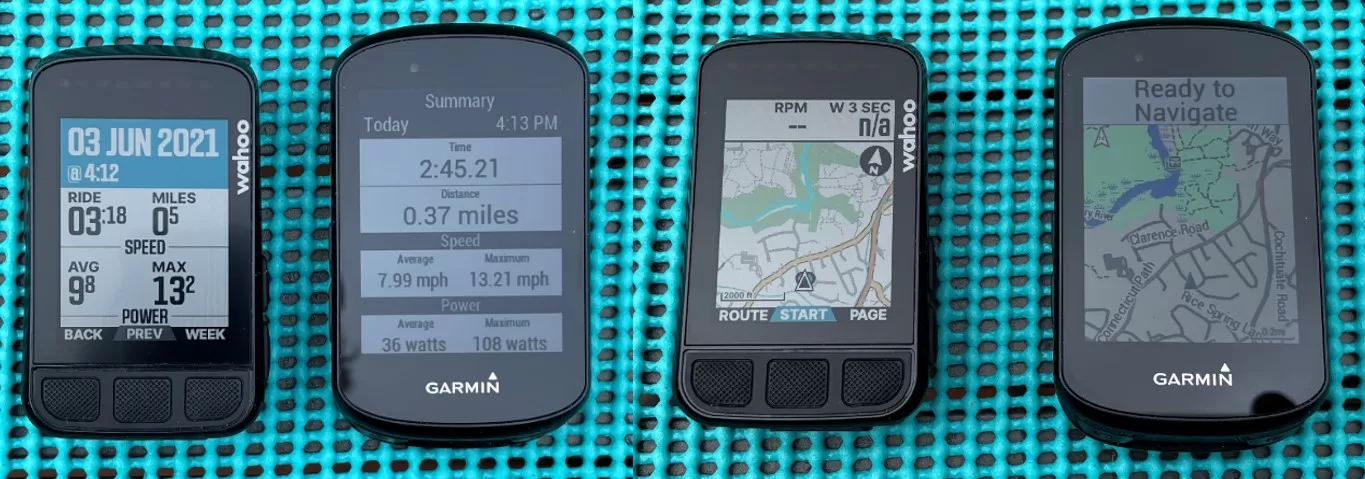

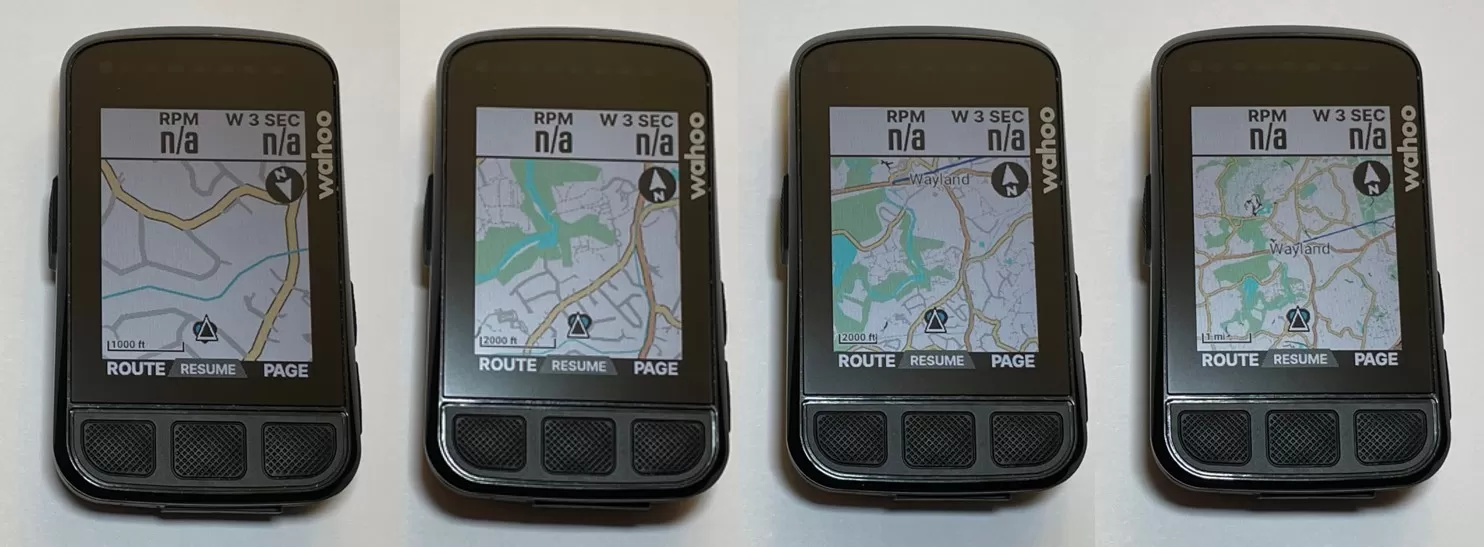
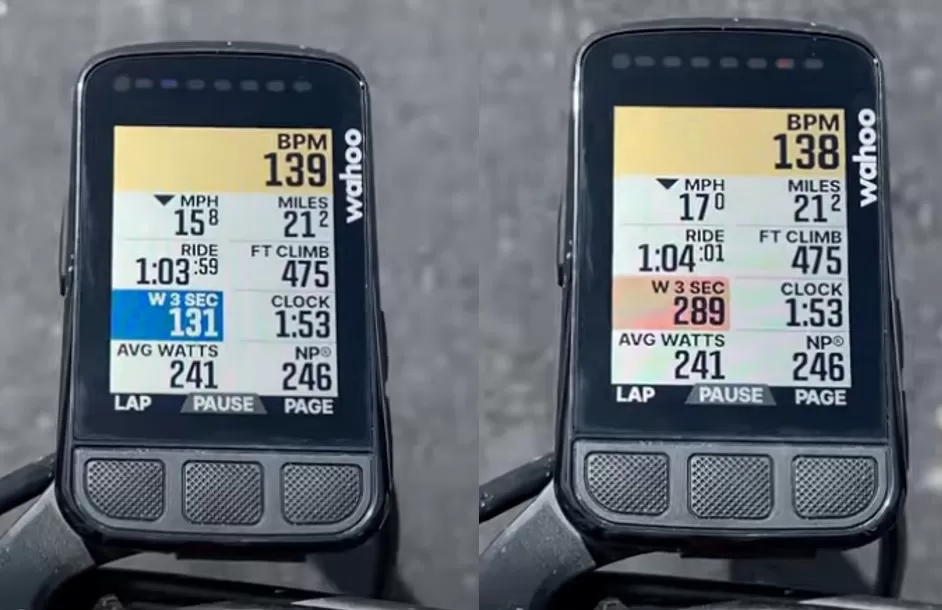


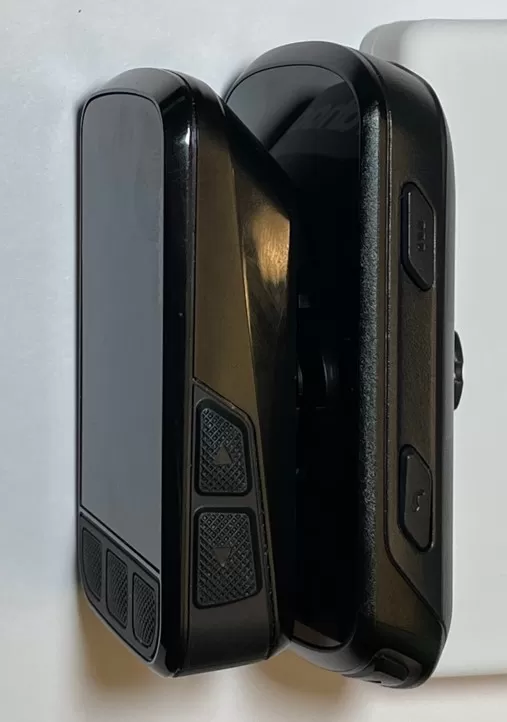
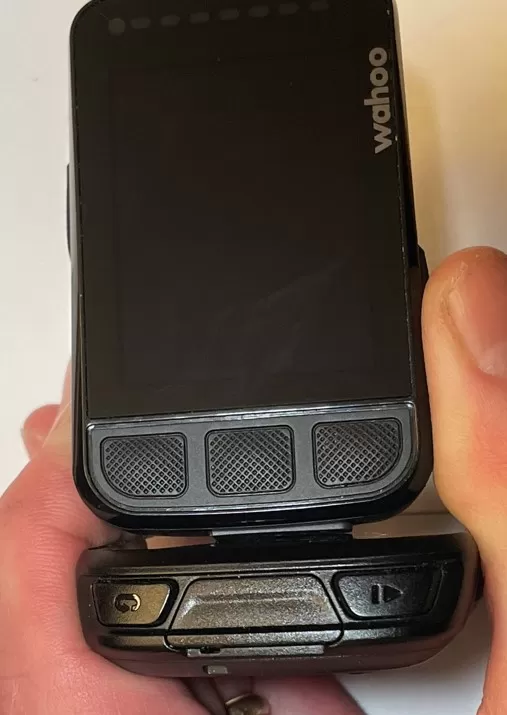
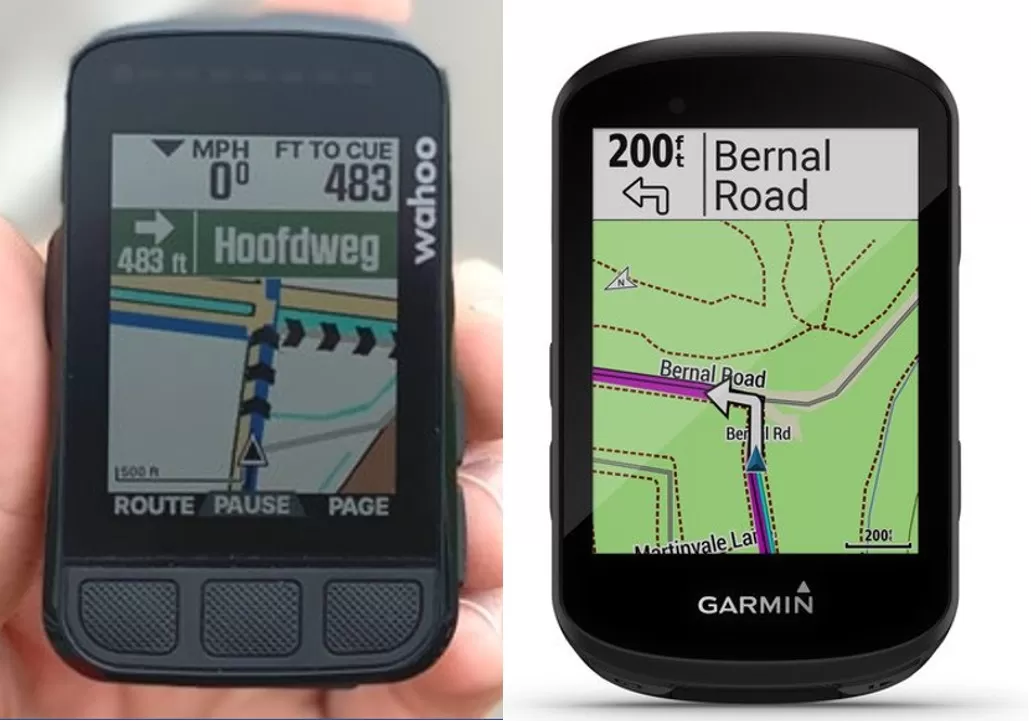
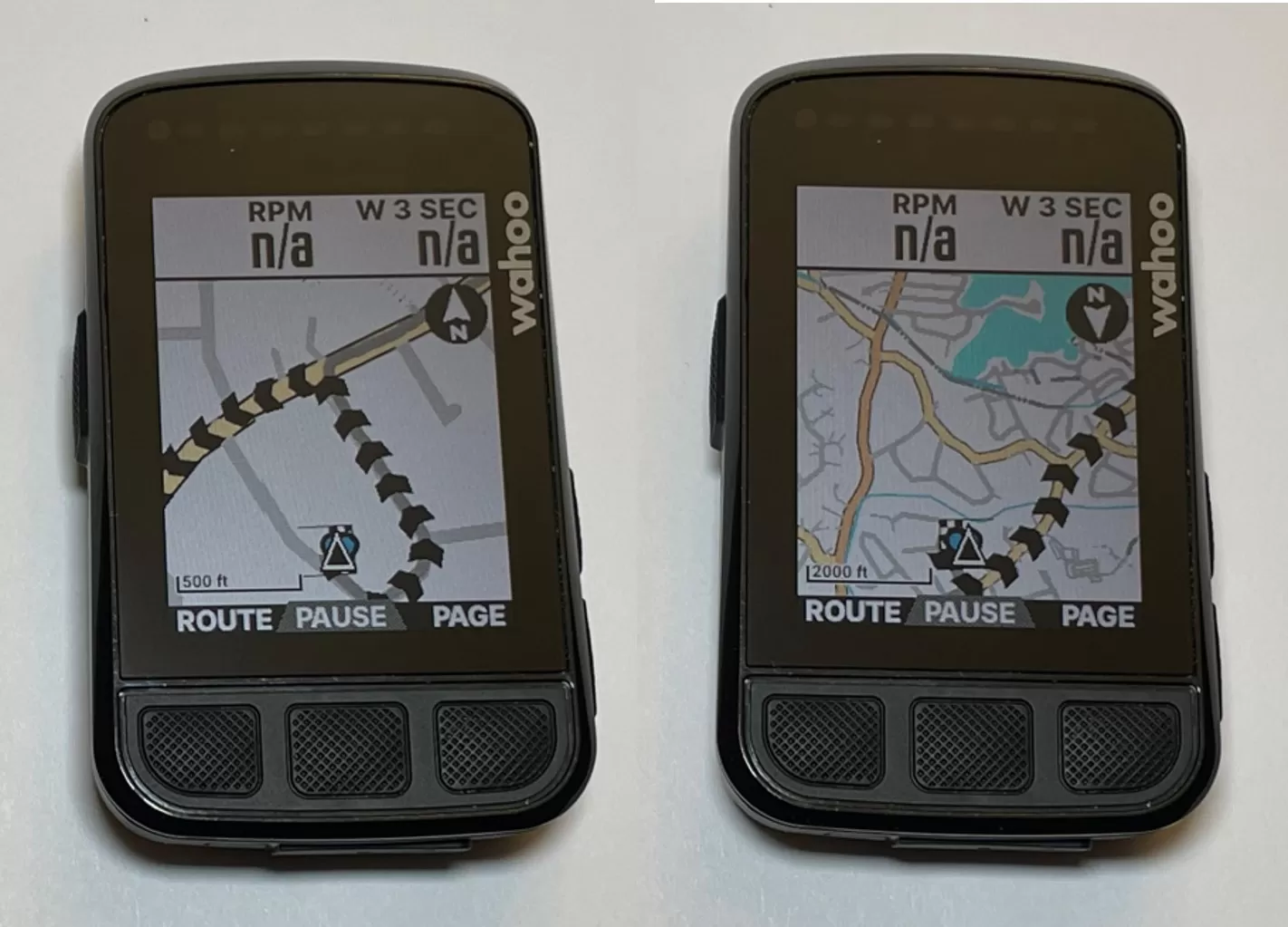
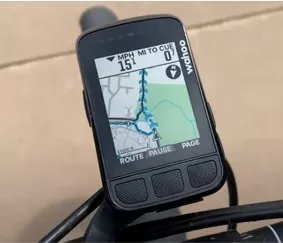
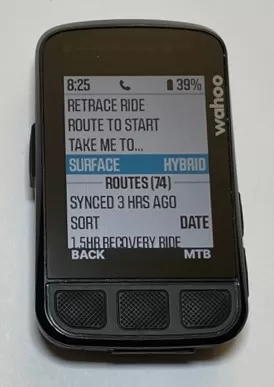

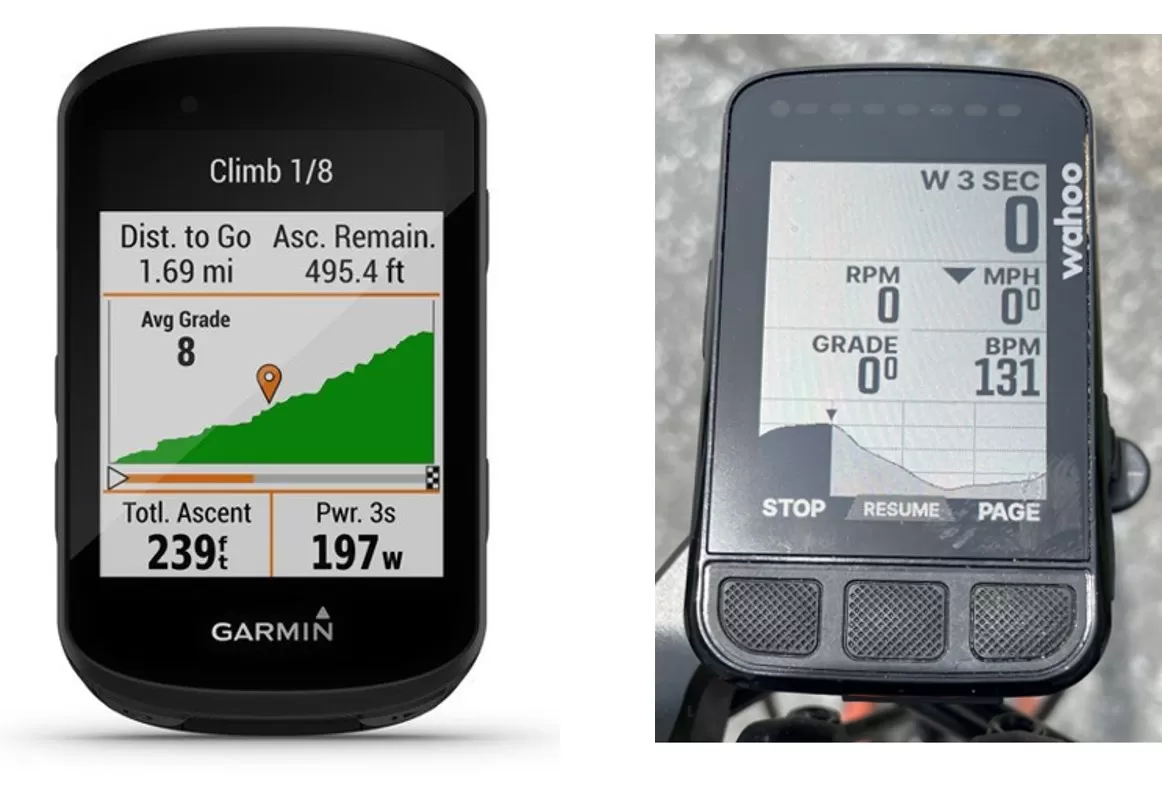
Hi Steve. Simple question. Does the Bolt maintain bike profiles to support different bike mileage records (for maintenance purposes)? Thanks.
Wilson, No. I’m not aware that any head units do this. Most people accomplish this by uploading their ride to Strava where you can select which bike you used for each ride and track your total mileage/bike that way. Steve
Wahoo doesnt but Strava will and Garmin Connect will.
The Bolt is clearly the easiest bike computer/nav unit to set up and use (thanks for explaining that real well Steve), except…. Not only doesn’t it have the ability to keep track of different bikes (i.e., like Garmin’s profiles) but it doesn’t even have an “odometer” to track your total mileage (which is strange since even the cheapest of cheap Cateyes do this and the $70 Bryton can do this with two different bikes).
So for those of us with multiple bikes that like to know the “odometer reading” of each for maintenance purposes we are left with either keeping a manual log (how much un-21st century can you get?) or regularly going onto Strava to make sure that each ride that wasn’t on my “default” bike is assigned to my other bike. This is type of hassle is quite the opposite of everything else about the Bolt’s “Done. Worry about other things.” nature (I’m not using your quote Steve to criticize or make fun of you in any way…it just seemed like the right words for the situation).
If Wahoo would add an odometer then I’d be happy to buy a 2nd Bolt so I would always simply and automatically have total mileage info for each of my two bikes (note to Wahoo – wouldn’t you rather sell me two Bolts vs. one?). Or maybe someday the Bolt will be able to detect what bike you are on (not a big technical challenge) and then sync the ride to the correct bike in your Strava profile…that would really put the cherry on top of the Bolt’s “Done. Worry about other things.” design goal!
As I’ve written, Garmin wins the endless features battle, except… this Garmin feature isn’t exactly as you suggest. First, the Garmin head unit doesn’t have an odometer on it let alone one that tells you how many miles you’ve ridden on different bikes.
Instead, you set up different bike profiles in Garmin Connect and choose between those uploaded profiles to your Garmin head unit before you start a ride. When done, the ride info including mileage is sent back to your Garmin Connect. There is no sensor on the Garmin head unit that knows what bike you’re on. If you forget to choose the right profile, you have to go into Connect and update the ride info.
This is one of those features that, if you’re hooked on the Garmin ecosystem and feel the need to track your overall miles, let alone miles per bike, is a plus in the Garmin Edge’s column. But unless you’re the equivalent of a “one-issue voter” might not be decisive for most in choosing between Garmin and Wahoo.
For me, Garmin Connect is inferior to Strava or things like Training Peaks or Trainer road in evaluating your performance and fitness. And, I put things like how well I did against my workout objectives and intervals or ride TSS and accumulated CTL ahead of total mileage and average speed. My wife always asks me how long I rode but, if she didn’t, I would almost never look. But that’s just me.
Understood and I didn’t mean to over-simplify how the odometer feature works in the Garmin ecosystem (and yes, having to remember to switch between bike profiles on a Garmin head unit is perhaps just as much a pain as making sure your rides are assigned to the right bike in Strava).
But at least Garmin attempted to address something that most would never expect to be part of the cycle computer/GPS “feature wars” (I’m talking total miles; not FTP, VO2, …, when to take a drink or pee…). So I do find it head-scratching that Wahoo chose to ignore the fact that “odometer” data is and has always been a basic/fundamental part of cycling “metrics” (or perhaps they knowingly chose to ignore it because it’s Strava’s job to deal with it instead).
Anyway, I definitely wouldn’t own a Garmin just because of their “profile” feature or even their latest must-have “ClimbPro”. Dealing with Strava to get total miles ridden per bike while using a Bolt is a small price to pay vs. the constant frustration I have with Garmin’s button ergonomics and strange UI/UX design…but you already know that and did a great job of explaining it!
Completely baffled about being so concerned about an odometer on a bike computer. It’s not even in the top 10 of metrics for data captured that are of importance. Strava or any other training platform can track your total miles.
My Garmin Edge 510 has an odometer and records total km travelled. If that’s not a feature on Wahoo GPS computers, that’s baffling.
Not to me. Most who look for an Garmin or Wahoo GPS computer upload their ride results to Strava, Training Peaks or other software that captures distance and wide range of other metrics helpful in improving their performance. If distance, speed and other basics are most important to you, you don’t need to spend the money on a GPS computer.
Thanks for the comparison, I’ve been using a Bolt since I (re)started cycling in earnest last year and just picked up a 530 after Decathlon had a great deal on it, “only” 200€. I did that mostly to get the ClimbPro feature as I’m planning on doing a lot of climbing this summer in the Alps and after being frustrated by what the Bolt offered in this respect on some recent climbs in the Vosges, i.e. nothing apart from a small profile for the upcoming route. When you have a 10km climb lined up the more info you have to help you make it won’t hurt 😉 I’m also getting a Varia Radar after some close calls while descending (can’t hear a thing obviously) and was interested in the color display.
After a Sunday outing I did find out a few additional differences of interest I think :
– while the 530 will reroute as you noted, you cannot send it a new route while an activity is underway, you can do that with the Bolt via the app, either with one destination point directly from the app or creating a new route on Komoot (or others) and sending it via the app.
– you mention the navigation pop-ups that are less invasive on the Bolt. True but the flipside is that I don’t find that they provide enough useful guidance, I’d rather be on my favorite data screen and have a full legible map pop up when needed and then have it go away automatically. On the Bolt I find myself stuck in map mode when I don’t know the area well to avoid missing a turn.
– Di2 interaction is way better on the 530, you have three actions per per lever, so 6 in total, vs 2 (one on each side) for the Bolt so that takes care of “button” problems (I haven’t really seen them so far). Also you can see your exact speeds and can select the actual FD/RD you’re using, on the Bolt it just get whatever the Di2 sends it (wrong in my case).
– the battery life actually seems rather good on the 530, in fact I’ve never been too impressed with the battery life on the Bolt, but it’s easy enough to top off regularly and I don’t plan on ever riding for more than 5 hours straight.
– The 530 has a ton more “fitness” metrics (VO2Max, Training Load, HRV, etc…) than the Bolt, that has…zero on board or even in the app. Everything has to be done on web apps like Runalyze.
Finally I noticed very different power readings between the Bolt and the Edge during my ride and after looking at the files I noticed that for some reason the Bolt was mostly using my Assioma Duos as Unos and since I’m a bit unbalanced (47/53) it was too low. This had never happened before so it has to be some kind of interference between the Bolt and the 530 🙁
Couple of pointers:
If your course is in Connect you can sync during an activity and run it without starting a new one.
Garmin navigation pop ups can be set to be text overlay on the screen you’re on, or quick switch to the map preview.
Haven’t used the 530, but with navigation & multiple sensors I get up to about 20hrs/500km on the 830. Best was 50% battery drain after 12/400.
Hi thanks for a great article! I now
have the Bolt v2.
Historically I have used Garmin product so all my data are on Garmin Connect and would like to continue having that as my “master”.
Question: Do you know if it’s possible to sync data from Wahoo or Strava to Garmin Connect? If not – are you aware of a another automatic workaround?
Wahoo direct to Garmin, no. But if on iOS, you can use 3rd party app like RunGap or export .fit from Wahoo, upload to Garmin.
David, you just have to export your ride from Strava (you can export the GPX file, or the original FIT file, but I recommend the FIT file because the GPX file will not have the power data) and then just upload it to Connect. I have been using Connect a lot as I have a Fenix 6 so bought a 530 to replace my Roam thinking I’d be happier with the direct integration. But I have to say the niggles of the 530 (crap UI, limitations on data fields for screens, poor/slow rerouting on courses, crap integration of courses in general, screen harder to see) just drove me crazy, so I’m fine doing the manual upload once I finish the ride. It’s really not a big deal at all.
David, I don’t know if that’s possible. Might want to ask Wahoo or Garmin support. Steve
Just wanted to point out that on the 530, you can have 2 data fields on the map screen. So you could technically be on the map and see say, power and HR. But on the Roam at least (not sure about the Bolt V2), you can have up to 6 data fields on the map screen, which for me is a godsend, because I love to make new routes and follow them, and I like to not have to switch between pages as much. So I put the most pertinent info on the map page, and then I can swap to the data page (which is actually the elevation profile page, but with a bunch of data fields, another win for Wahoo) for metrics that I might not be interested in in a more immediate way but as the ride progresses I might want to know (like average speed, etc).
Hi. Thanks for the useful review. I have the 530 which has sensor connection and navigation bugs right now. Am considering the bolt v2. Does a map flash up for turns, when following a route? I like this feature on edge units.
No. Turn instructions but no map flash.
Hi Steve,
Great review, the only one in fact that replicates my positive opinion about the wahoo bolt versus de garmin 530. However, although my absolute preference for the clever user interface and daring choices wahoo made, I keep on having very annoying problems getting my routes from my phone to the bolt…
The problem is that I *NEVER* get my route onto the BOLT the first time. I always have to retry at least twice, which is not something you want to do at the start of a ride, with a whole group of riders waiting for you. A couple of times it happened that it was not possible at all to transfer the track, but that was very exceptional.
The only thing the helpdesk keeps on repeating is referring to bluetooth connnection problems, and suggesting to forget and reconnect the bolt, which I have done a 1000 times by now.
This is a problem already going on for years, and I have had the same problem on different BOLTs (this is my third bolt). To make things worse, the wahoo helpdesk is absolutely useless, and it is a complete loss of time explaining them over and over again what the problem is: they keep on giving the most idiotic and useless answers,…
So, anyone having the same issues, what is the cause, and is there a solution? (My phone is a iphone mini, and previously an iphone SE)
rgds,
peter
Well, i’ve just switched from the 530 to the Bolt v2 and am very happy. The bolt is much easier to use. I love the phone app. I do miss the TBT pop up map on garmin a little bit but then there is a bug where it zooms in too much to make sense. The 530 also has a sensor drop bug that has yet to be fixed after 6 months !! My only criticism of the bolt is that the final TBT bleep / instruction comes a bit too late when in a city with multiple turns near to each other. Overall i’m really happy and don’t expect to switch back to garmin.
I would add that whilst the battery life on the Bolt2 is fine, it is nowhere near as long as the garmin 530. This is for daytime riding when i would personally switch off the backlight on both units (and i’m 49 with mild short and long sighted eyes).
Interesting review and comments regarding Wahoo V Garmin. I’ve been a Garmin user for many years from the 500 up to the 820, however after many reviews on various websites and utube I purchased a Bolt 2 a few weeks ago, unfortunately I am very disappointed in the Bolt, out of the box set-up went well, pairing and connecting to my Android phone straight away. However following a few rides Bolt would not connect despite trying all suggestions from Wahoo customer support. I found that resetting the Bolt back to the factory setting allowed connection to my phone but get no response when trying to set up the pages, it finds and pairs with sensors okay (HR Cadence Power etc) but no response to page settings. Very disappointed so back to my Garmin.
Interesting review. I recently purchased the latest Wahoo ELEMNT Bolt and have noticed that the unit gradually loses charge while switched off.
It might be fully charged to 100% and then when switched back on 24 hours later find the charge has dropped to 95%.
Is that common? I assume there must be some apps running in the background or some problem with the health of a new battery.
What would you recommend?
Bruce, I’ve not noticed that with my unit. I’d suggest you contact Wahoo and see what they think is going on. Steve
Hi Steve, are you still recommending the wahoo element Bolt? Also, would you recommend the Roam over the Bolt? Thank you!
Sam, I do unless there is a feature that the Garmin has that is a must for you or you are hooked into the Garmin ecosystem. With the improvements made in the 2nd gen BOLT, it now is everything that the ROAM is. The only reason to get the ROAM would be if you prefer the slightly larger screen size and are willing to pay extra for it. Steve
Hi Steve. As a garmin 530 user there are 2 things in your comparison that are not quite accurate.
-The garmin just like the wahoo does not need any 3rd party software to control the resistance of a smart trainer. It’s very simple to re-ride any previous routes or courses saved on the head unit and it communicates directly with the trainer.
-Just like on the Wahoo, the Garmin allows one to add 2 data fields to the navigation/map screen.
Well I’ve had the Bolt for 10 minutes and scanning the QR code doesn’t launch anything and the backup option to “pair phone” doesn’t show up anywhere by following the instruction. Review: POS
Now to try and find some instructions to bring this thing to life and investigate Garmin. Life is too short to screw around with poor tech.
I have garmin Edge 1030 plus for about a week and it’s the worst “flagman” I ever had.
The screen is very dim and even o the brightest settings it’s not near to the pictures from their website, unlike wahoo. I’d prefer bright and crisp black-and-white screen to colorful and dull screen of 1030+
Setting up all the profiles is .. moderately difficult.
Structured workouts page on Garmin shows only power metrics, no cadence or HR.
I also doubt the unit holds battery for 24 hours, as promised. I used it for two hours (1.5 hour ride and 30 minutes of fiddling with the settings) and now it show I have 86% of battery – an equivalent of 15 hours of usage.
Yes, ClimbPro is a great feature. The only great feature not yet released by Wahoo (Hammerhead already has even better version of it).
My verdict: Garmin is way behind in the user experience and usability of their products. Their product is full of features that are difficult to use and not explained properly.
Wahoo’s latest firmware update(s) now includes a new “Summit” feature which looks like the 1st step in catching up with Garmin’s “ClimbPro”. This was expected since everyone is going ga-ga over ClimbPro.
So Ira, respectfully, I don’t care to share or debate every update of product specs and features with readers. There are other sites that do that. Perhaps best to post this type of information there. I’ll not get into that anymore with you here. As I’ve written, if you are into these kinds of added features, Garmin has it over Wahoo.
But to again clarify the information you are posting here, the Summit feature is something that’s been available on the Wahoo Bolt 2 units since shortly after it was introduced last summer. It’s not as comprehensive as the Climb Pro or what you can get on the Hammerhead Karoo but to say “everyone is going ga-ga over ClimbPro” is hype. You and others may be and Garmin may be marketing this feature in the media but I don’t know that “everyone” sees this the same way. Steve
Finally ready to upgrade my original ELEMNT Bolt that I’ve had for ~6years. Obvious choice since I enjoyed it so much was the Boltv2. However, I’m seeing a lot of mixed reviews on the Boltv2 on shop review pages (REI, wiggle, amazon, etc). DCrainmaker wrote about a lot of these issues in his admittedly fairly out of date review, but the discussion comments on that page seem to indicate these issues still haven’t been fixed.
They seem to be mostly centered around 3 categories of usability issues: battery charging / drain, unit SW crashes and sensor drops, TBT navigation glitches.
You seem to be pretty happy with yours Steve, does that mean you haven’t encountered these issues? Or have you hit them and they’re rare enough you aren’t bothered? Anyone else have feedback on these areas?
circuit biker, Frankly, I’ve never seen these issues on my two BOLT V2 units (one purchased at the time of the release of the new model last year and one in September this year) and wasn’t aware that some are experiencing problems. Steve
Accident notification and bike alarm alone are reasons to have the Garmin, both of them saved my ass. Everything else is as near as makes no difference, although I prefer Garmin maps.
@circuit breaker: the only issue i have is that the second/final alert on the TBT is too late. The map page still works fine and you still get a first alert in good time, so the navigation is perfectly usable. Never had a sensor drop and i have 2 bikes with 2 sets of sensors – and i switched from the garmin 530 because of this issue. Can’t recall a FW crash either.
Interesting review. Just wanted to share my experience if it helps anyone. I have had the Garmin Edge 830 and the Wahoo Bolt V2 which I currently own now. The main reason I went to the Bolt V2 was with vision issues it was a little easier to see the data compared to the glossy screen of the Garmin. Why you would have a mirror gloss screen on a device to be used outdoors is beyond me. Anyway, once in use with the Wahoo I had it die on me 3 months after very casual use. It would not power up or randomly fail mid ride. It finally stopped powering up altogether and Wahoo was nice enough to send a replacement. I tested a few rides on it, and in mapping with several tight turns I found it was giving me directions faster than I could keep up, and in an unfamiliar area it doesn’t help to have a direction pop up then go away before you’ve even got to the turn. Garmin didn’t do this and was much easier follow. Also having no street names was a problem on the Wahoo. Garmin had street names on the map which was very helpful when navigating in unfamiliar areas. So kind of a mixed bag for me. Wahoo is easier to see, Garmin is better to use mapping use in the way I use it. The other thing is I like not having to go to multiple places for post ride data, and I prefer not to have to pay a subscription to do it . Garmin Connect has most of these features on the website version for free. Wahoo only has an app, with no post ride analysis available outside your phone. The calendar on garmin connect is very useful, and also being able to see how much time I have spent on my MTB vs road bike. This is helpful also for calculating maintenance hours for my MTB on things like my shocks which have service hour intervals. I currently have my wahoo up on ebay as I just prefer the mapping and connect website. I will be waiting for the garmin edge 540 when it comes out this summer and be buying that most likely.
Hi Steve-
I’m in the market for a bike computer- I recently lost my ELEMNT bolt. Do you still recommend it over other options? Or should I be looking at options that have emerged since your last review? Karoo? A newer Garmin?
Thanks
Biren
Biren, I’ve been using the Roam 2 this season and currently testing it against the Karoo 2. Will be adding in a Garmin 840 later this summer. Karoo 2 is a has some advantages and limitations depending on what you use your bike computer for. Roam 2 is like a bigger version of the Bolt which I think gives you more than the Garmin 530. If you were happy with the Bolt, I think you would be with the Roam 2 as well. You can find it at the same stores I linked to in the post above. Steve
Thanks Steve!
Hi Steve-
Quick follow up question. What’s the difference between the bolt v2 and roam v2 besides the larger screen on the latter?
I tried going through the differences on Wahoo’s website but besides the screen and slightly better GPS on the Roam, I don’t see much of a difference.
Thanks!
Biren
That’s basically it. But, with the larger screen comes a bigger display that I find makes a difference if you use the maps to navigate your ride.